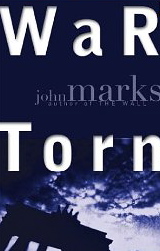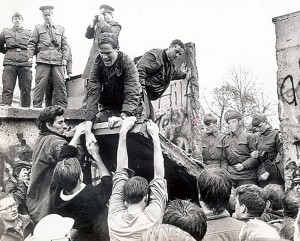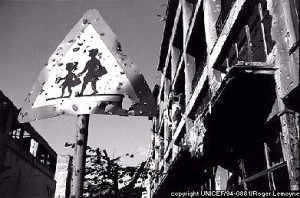“Cities revolving within cities, constantly arising and collapsing, the healthy giving way to the sick, the sick returning to health. And the people were like the cities, containing their own deaths, and within their own deaths, other lives, unexpected, as shocking as the fact of mortality.”
Within t his engrossing story of love and war in Berlin and Mostar, Yugoslavia, from 1989 to 1992, John Marks considers the subject of divided cities-and the damaging effects on the people who live in them. The Wall dividing East and West Berlin has just come down, and Germany is in the process of reunification, attempting to erase the invisible walls still dividing the people of Berlin and of Germany as a whole. Arthur Cape, an American reporter for Sense magazine, has been in Berlin since 1989, when he arrived there from India at the age of thirty. He and Eric Hampton, the senior editor, have been filing reports from Berlin, documenting the story of the reunification and the surprises which have accompanied it.
his engrossing story of love and war in Berlin and Mostar, Yugoslavia, from 1989 to 1992, John Marks considers the subject of divided cities-and the damaging effects on the people who live in them. The Wall dividing East and West Berlin has just come down, and Germany is in the process of reunification, attempting to erase the invisible walls still dividing the people of Berlin and of Germany as a whole. Arthur Cape, an American reporter for Sense magazine, has been in Berlin since 1989, when he arrived there from India at the age of thirty. He and Eric Hampton, the senior editor, have been filing reports from Berlin, documenting the story of the reunification and the surprises which have accompanied it.
Through flashbacks, Marks provides us with Arthur’s family background, establishing him as a sensitive man who, though once a Believer, has given up on religion, preferring now to think about justice in a more immediate and practical sense. On his way to a Halloween party, given by Anna, his girlfriend, in 1992, he sees a ghostly stranger whom he regards as a revenant (a messenger from the “other side”), and he knows instinctively that this messenger comes with information about Marta, a woman he has not seen or heard from in three years.

Gradually, the story of his earlier relationship with Marta unfolds. Three years ago, Marta had been living with her husband and child in West Berlin for several years, having escaped early from the unrest in Mostar, Herzgovina, where the rest of her family remained. She had always hoped to stay in Germany to give her son a chance to live in peace, though her husband was determined to return to Mostar to open a restaurant. Inevitably, during one of her husband’s absences, she and Arthur found themselves falling in love, treasuring the moments they had together, with no sense of what the future might hold for either of them. Their love, of course, soon ran afoul of reality, and complications ensued, driving then apart. Now, three years later, a messenger has brought news of Marta, and Arthur finds himself drawn once more into her life.
Through Marta’s story, the history of the ethnic unrest in Yugoslavia unfolds. The daughter of a movie star who has married three times, each time to someone of different ethnic background, Marta is a Muslim, though her sister Dubravka, who occasionally visits her in Berlin, is a Serb, whose allegiance is to the Christian Orthodox church. Her brother Mato is a lapsed Catholic. A close family friend, Mose Silber, who regards himself as a barely observant Jew, adds to the ethnic mix among her neighborhood and friends and moves freely among the various groups. Until the fall of the Iron Curtain, which had kept the city’s strong ethnic and religious allegiances in check, all had managed to live compatibly and relatively peacefully in Mostar.
Now, however, the various ethni c groups are all competing for their own influence and power, with unprincipled criminals pushing to establish separate ethnic states and willing to fight to achieve these goals. As the story alternates between Berlin and Mostar, and between Arthur and Marta, the reader observes the growing brutality among the various groups, and when Marta’s brother, a partisan, comments to Marta on the state of civilization there, the effect is chilling: “The United Nations says that there are two kinds of people left in this valley. Catholics and Muslims. But the United Nations doesn’t know shit. There are only two kinds of people, ever, anywhere, at any given moment, in this world; those who have slit the throat of another human being and those who who haven’t. Branko is in the first category. You are in the second.”
c groups are all competing for their own influence and power, with unprincipled criminals pushing to establish separate ethnic states and willing to fight to achieve these goals. As the story alternates between Berlin and Mostar, and between Arthur and Marta, the reader observes the growing brutality among the various groups, and when Marta’s brother, a partisan, comments to Marta on the state of civilization there, the effect is chilling: “The United Nations says that there are two kinds of people left in this valley. Catholics and Muslims. But the United Nations doesn’t know shit. There are only two kinds of people, ever, anywhere, at any given moment, in this world; those who have slit the throat of another human being and those who who haven’t. Branko is in the first category. You are in the second.”
In a unique and thought-provoking thematic twist, Marks draws parallels between what has happened in the division and reunification of Berlin and what is about to happen in Yugoslavia. As he recreates the ambiance of Arthur’s day-to-day life and observes Berlin as the Wall comes down, his descriptions come alive, and the experience of living in a deadened, divided city haunts: “[In East Berlin] buildings were soot-caked and bullet-holed. Tenements had been left to disintegrate. Matter itself had been punished. The dilapidation smacked of Yugoslavia bu t in the neighborhoods of eastern Berlin, the ugliness verged on beauty, the survival of a city [which had been] annihilated.” As Arthur muses on the philosophical implications of division and reunification in Berlin, he is also aware, through Marta’s story, that simultaneous events occurring in Mostar may lead an inevitable and terrible division.
t in the neighborhoods of eastern Berlin, the ugliness verged on beauty, the survival of a city [which had been] annihilated.” As Arthur muses on the philosophical implications of division and reunification in Berlin, he is also aware, through Marta’s story, that simultaneous events occurring in Mostar may lead an inevitable and terrible division.
The novel gets off to a quick start with the appearance of the Halloween “revenant,” and Marks’s crisp prose and ability to select perfect, illustrative details advance the action and keep the story moving at breakneck speed. The peaceful reunification of Berlin offers a poignant and moving contrast to the growing violence of Mostar, with Marks presenting a clear picture of the conflicts through the action, never allowing the complexities of historical background to overwhelm his story. As bridges in Berlin are reopened, the parallel destruction of bridges in Mostar creates a heightened sense of foreboding and tension. Irony abounds, especially when a German, Hans Kreichler, becomes the European administrator of Mostar during a temporary cessation in the violence there. Most of all, however, this is a moving love story about two fully drawn people for whom love and war exist on parallel planes. As they struggle to reconcile within their own lives the tension between their hopes and disappointments, dreams and torments, and aspirations and earthly cares, the reader sees their struggle as a universal one-one waged by thoughtful individuals, enlightened governments, and philosophers and clerics the world over.
Notes: The author’s photo is from http://www.myspace.com
The Berlin Wall comes down: http://www.dailymail.co.uk/
The street scene with the bullet-ridden Children’s Crossing sign is by Roger Lemoyne for UNICEF, and is published on http://www.friedenspaedagogik.de/
